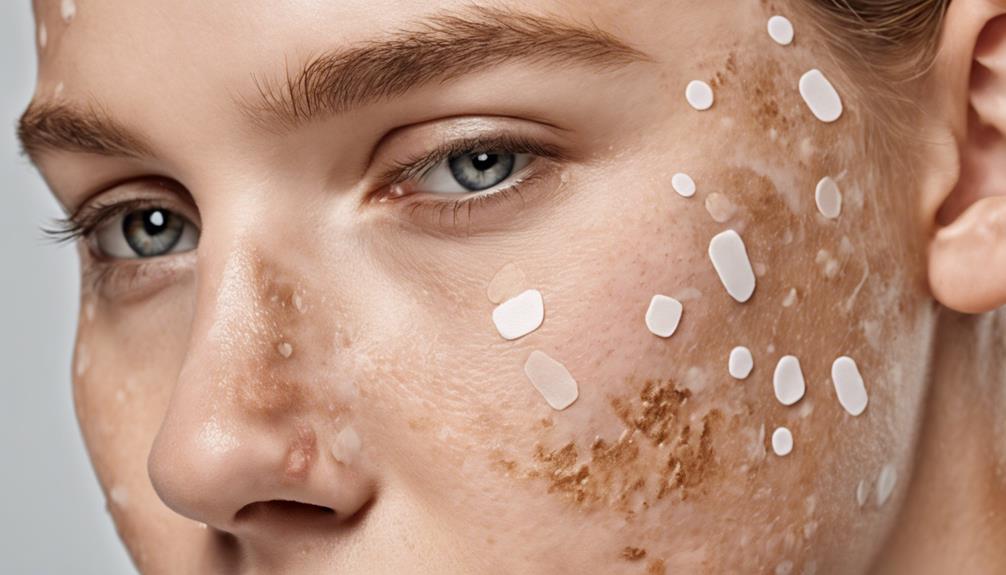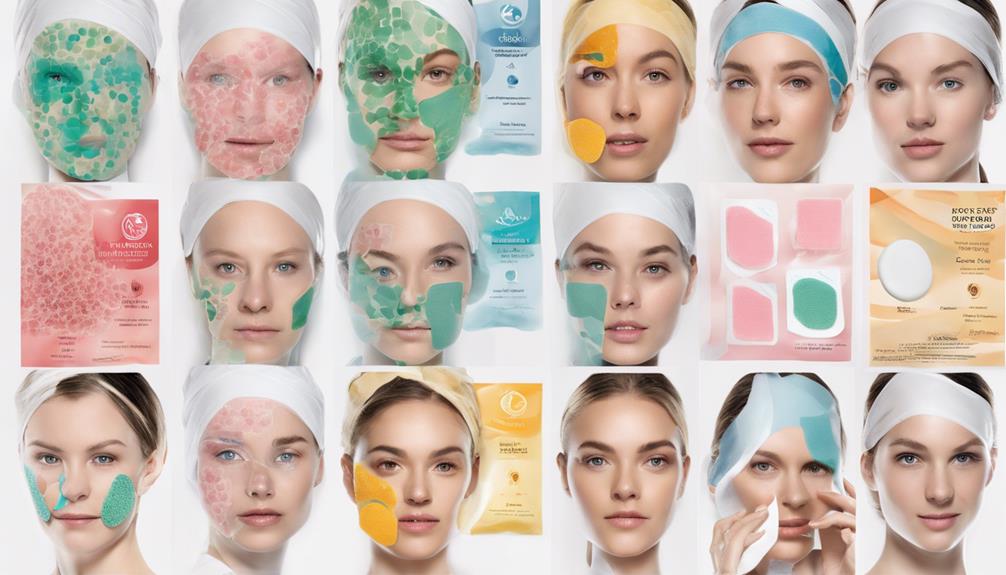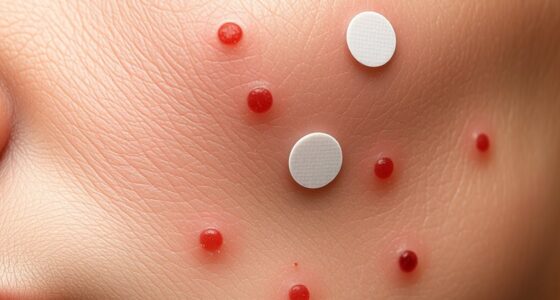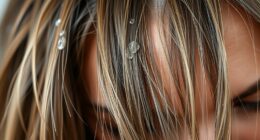Acne patches are effective because they use ingredients like hydrocolloid, salicylic acid, and tea tree oil to absorb oil, reduce inflammation, and accelerate pimple healing. They serve as a protective barrier for clearer skin. Various types of patches target specific pimples, boosting their effectiveness. Ingredients such as salicylic acid and tea tree oil address different skin concerns. In addition to promoting faster healing, they also prevent further damage, reduce inflammation, and protect against scarring. Choosing the right patch, correct placement, and clean skin ensure maximum efficacy. For more information on the benefits and tips for achieving optimal results, please refer to the detailed research content.
Key Takeaways
- Acne patches work by absorbing pus, promoting healing, and preventing further damage.
- Ingredients like salicylic acid and tea tree oil target specific acne types effectively.
- Hydrocolloid patches provide a protective barrier and aid in faster recovery.
- Visible results, reduced inflammation, and clearer skin can be seen within hours.
- Proper application, clean skin, and consistent use optimize acne patch effectiveness.
How Acne Patches Work
Acne patches work by utilizing hydrocolloid, a gel that absorbs drainage from pimples and supports the healing process. This gel acts as a protective barrier over the pimple, preventing further irritation and reducing inflammation. By absorbing the fluids released by the pimple, hydrocolloid helps to promote a moist environment that's conducive to healing. This process aids in faster recovery and minimizes the size of the blemish.
When pimples are open, draining, or in the healing stages, hydrocolloid patches are particularly effective. They create a safe space for the skin to repair itself by preventing external elements from causing more damage. Additionally, for those who've the habit of picking at their skin, these patches are beneficial as they prevent infection and promote a quicker healing process.
While acne patches aren't meant for preventing breakouts, they're specifically designed to treat active pimples by absorbing fluids and supporting the skin's natural healing mechanisms.
Types of Acne Patches

When it comes to types of acne patches, understanding the materials used is essential. Different patches are tailored for specific types of pimples, showcasing their effectiveness.
Knowing how to apply and remove these patches correctly can maximize their benefits for clearer skin.
Popular Patch Materials
Hydrocolloid bandages, a popular type of acne patch, are crafted from a gel-forming material known for its wound-healing properties. These patches are designed specifically for treating acne, with an outer protective layer and an inner layer that absorbs fluid from pimples to promote healing. Below is a table showcasing popular patch materials used in acne patches:
| Patch Material | Description | Benefits |
|---|---|---|
| Hydrocolloid | Gel-forming material aiding in wound healing | Absorbs oil, dirt, and fluid |
| Salicylic Acid | Exfoliating properties to unclog pores | Reduces inflammation |
| Tea Tree Oil | Natural antibacterial and anti-inflammatory properties | Calms and soothes the skin |
These materials are carefully chosen to address various acne concerns effectively.
Effectiveness on Pimples
While tailored to address specific types of pimples, various acne patches contain ingredients that enhance their effectiveness in treating breakouts. These ingredients are carefully selected to target different types of acne, ensuring the patches provide best results.
- Hydrocolloid Patches: These patches are particularly effective for raised pimples with visible pus, as they work by absorbing excess fluid and promoting a moist healing environment.
- Specific Type: Different patches are designed with ingredients tailored to specific types of pimples, such as cystic acne or whiteheads, maximizing their efficacy.
- Ingredients: The unique blend of ingredients in each patch plays a significant role in enhancing their effectiveness and addressing various acne concerns.
Application and Removal
Acne patches, including hydrocolloid patches, medicated patches, and acne dots, offer targeted solutions for different types of acne concerns.
Hydrocolloid patches work by absorbing excess oil and pus from pimples, aiding in faster healing and reducing inflammation.
Medicated patches contain ingredients like salicylic acid or tea tree oil to target specific acne concerns such as clogged pores or bacteria.
Acne dots are smaller, targeted patches designed to treat individual pimples, providing a more discreet and localized treatment option.
These different types of acne patches cater to various skin needs, addressing issues from open, oozing pimples to deep, stubborn cysts. Their versatility allows for tailored solutions, making them a convenient choice for managing different forms of acne.
Ingredients in Acne Patches

Acne patches often include ingredients such as salicylic acid, known for its pore-clearing and oil-reducing properties.
Tea tree oil, another common component, contributes to fighting acne-causing bacteria and reducing redness.
The inclusion of skin-friendly ingredients like hyaluronic acid and niacinamide can further enhance the effectiveness of acne patches.
Patch Effectiveness
Containing a variety of skin-beneficial ingredients, acne patches are formulated to target specific skin concerns for effective treatment. These patches often include ingredients like salicylic acid and tea tree oil, known for their acne-fighting properties.
Here are three key facts about the ingredients commonly found in acne patches:
- Salicylic Acid: Unclogs pores and reduces excess oil, aiding in treating acne.
- Tea Tree Oil: Has antibacterial properties that kill acne-causing bacteria and reduce inflammation.
- Hyaluronic Acid: Hydrates the skin, preventing dryness and promoting a healthy skin barrier.
Skin-Friendly Ingredients
Salicylic acid, tea tree oil, hyaluronic acid, niacinamide, and benzoyl peroxide are common skin-friendly ingredients often found in acne patches, each serving a specific purpose in targeting different aspects of acne.
Salicylic acid helps unclog pores and reduce excess oil, preventing breakouts. Tea tree oil acts as a natural antibacterial agent, killing acne-causing bacteria and reducing inflammation. Hyaluronic acid hydrates the skin, preventing dryness during the healing process.
These ingredients work synergistically to combat acne effectively. When choosing acne patches, look for these ingredients to maximize effectiveness in addressing various acne concerns. Remember, everyone's skin is different, so finding the right combination of ingredients that work best for your unique skin type is crucial.
Benefits of Using Acne Patches

By creating a protective barrier over pimples, acne patches help reduce inflammation and the risk of scarring. Here are three benefits of using acne patches:
- Faster Healing: Acne patches can absorb excess oil, dirt, and pus from pimples, aiding in faster healing and preventing further infection.
- Prevent Further Damage: They help prevent picking or squeezing at pimples, minimizing the chance of spreading bacteria and causing more breakouts.
- Convenient Spot Treatment: Some patches contain ingredients like salicylic acid or tea tree oil, which can unclog pores and reduce bacteria on the skin. Studies show that acne patches can reduce the size and redness of pimples overnight, making them a convenient and effective spot treatment option.
These benefits highlight how acne patches not only assist in healing but also play an important role in protecting the skin and preventing future breakouts, ultimately contributing to healthier and clearer skin.
Choosing the Right Acne Patch

When selecting the perfect acne patch, it's important to consider the specific type of acne you're dealing with. Different patches are designed for various types of pimples like pustules, papules, or cysts.
Take into account acne patches with ingredients such as salicylic acid, tea tree oil, or hyaluronic acid based on your skin's needs and sensitivity. It's vital to check the effectiveness of the acne patch by reviewing customer reviews and ratings to see if it has helped others with similar acne concerns.
Opt for acne patches made of hydrocolloid for open, draining pimples, as they can absorb excess fluid, dirt, and oil to aid in faster healing. Additionally, consider the design and visibility of the acne patch according to your preference; some patches are clear while others may be more visible on the skin.
Application Tips for Acne Patches
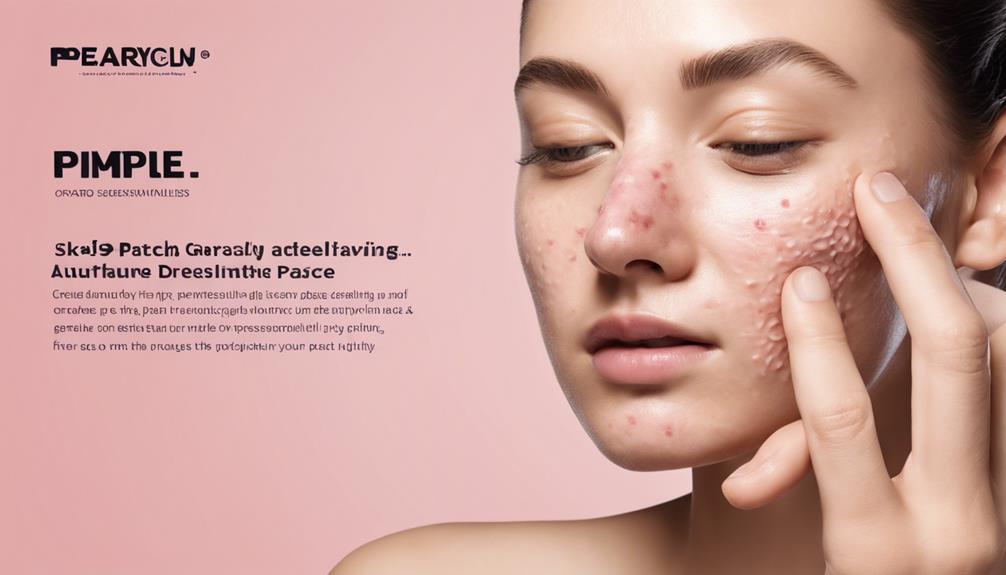
Prior to applying acne patches, confirm proper placement on the pimple area for effective results.
Remember to cleanse the skin thoroughly before application to promote adhesion.
Avoid touching or moving the patch once applied to prevent disruption of its healing properties.
Proper Patch Placement
For maximum effectiveness of acne patches, proper placement on the affected area is essential for effective treatment. When applying acne patches, consider the following tips:
- Cover the Entire Pimple: Make sure the patch completely covers the pimple to maximize its healing benefits.
- Clean and Dry Surface: Place the patch on clean, dry skin to help it adhere better and prevent irritation.
- Avoid Broken Skin: Don't place the patch over small wounds or broken skin to prevent further damage and promote healing.
These simple steps can enhance the effectiveness of acne patches, reducing inflammation, protecting the skin from external factors, and supporting faster healing of pimples.
Clean Skin Before
To ensure proper adhesion and effectiveness of acne patches, it's essential to cleanse the skin thoroughly before application. Cleaning the skin helps remove dirt, oils, and dead skin cells that can hinder the patch's ability to stick well and deliver the intended benefits of hydrocolloid dressings in acne treatment.
By guaranteeing a clean surface, the patch can effectively absorb impurities from the pimple and create an ideal environment for healing. Removing any makeup or skincare products from the area before applying the patch is necessary for maximizing its efficacy.
Properly cleansing the skin before using acne patches can greatly enhance their ability to reduce inflammation and promote the healing process, ultimately aiding in achieving clearer skin.
Avoid Touching Patch
We always suggest refraining from touching the acne patch once it has been applied to guarantee the best results and prevent any potential contamination. Here are three reasons why avoiding touching the patch is essential:
- Prevent Contamination: Touching the patch can transfer bacteria from your fingers to the pimple area, increasing the risk of further breakouts.
- Maintain Adhesive Properties: Continuous contact with the patch may reduce its adhesive properties, leading to premature detachment and reduced efficacy.
- Optimize Healing: Keeping your hands off the patch helps maintain a sterile environment for the pimple, allowing the hydrocolloid gel to work effectively in treating the acne.
Do Acne Patches Prevent Scarring?
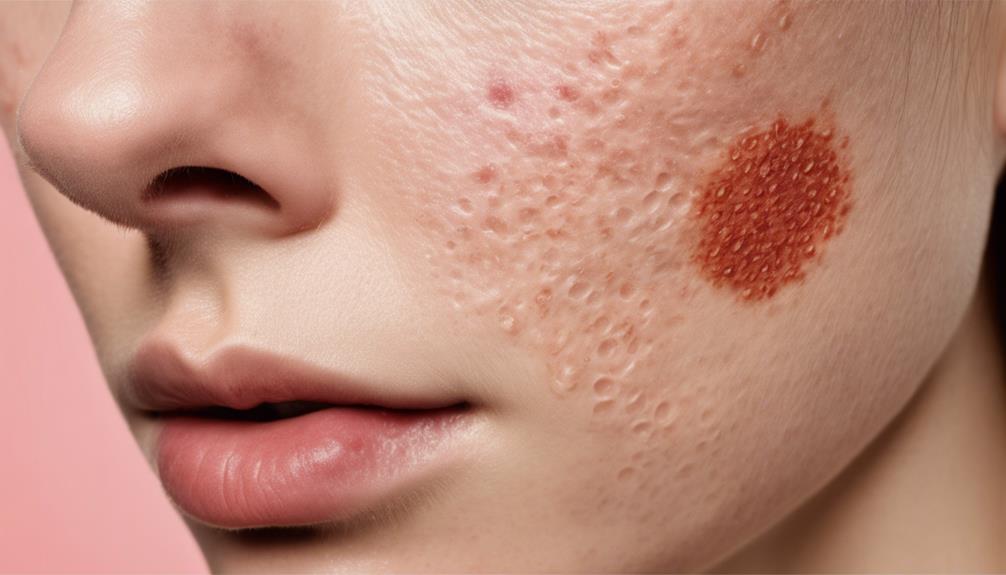
Acne patches play an important role in preventing scarring by creating a protective barrier over the affected area. The hydrocolloid material in these patches absorbs excess fluid and toxins, reducing the risk of scarring. By acting as a protective barrier, acne patches help minimize scarring by preventing picking and touching of pimples, allowing the skin to heal properly. Consistent use of acne patches on healing pimples can contribute to smoother skin texture and reduced scarring over time. Dermatologists recommend applying acne patches on open, oozing pimples to promote healing and decrease the potential for scarring.
| Benefits of Acne Patches | Emotion Evoked |
|---|---|
| Prevent scarring | Protection |
| Absorb excess fluid | Reassurance |
| Minimize picking | Comfort |
| Aid in healing | Hope |
| Smooth skin texture | Confidence |
Effectiveness of Acne Patches
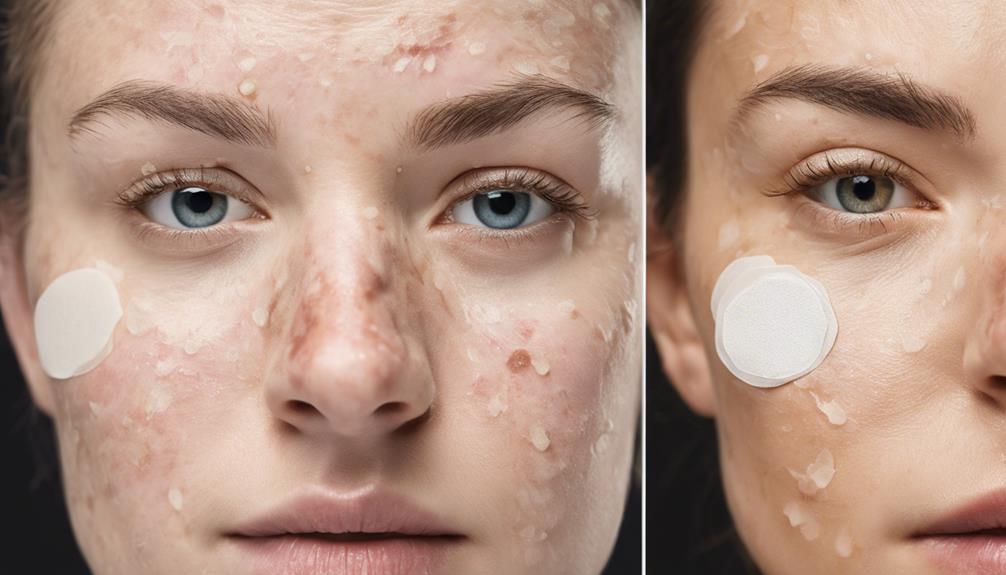
When evaluating the effectiveness of acne patches, it's crucial to examine the ingredients and their particular efficacy for various types of blemishes.
Understanding the timeframe necessary to observe visible results can also offer valuable insights into the patch's effectiveness for specific skin concerns.
Delving into these aspects can assist users in making informed decisions about incorporating acne patches into their skincare routines.
Patch Ingredients Efficacy
Exploring the efficacy of patch ingredients in acne treatment reveals the diverse benefits they offer for reducing inflammation and promoting skin healing.
- Salicylic Acid: This ingredient penetrates the skin to unclog pores, reducing acne-causing bacteria and preventing future breakouts.
- Niacinamide: Niacinamide helps to improve skin tone and texture, making it effective in treating active blemishes while enhancing overall skin health.
- Hydrocolloid Patches: These patches work by absorbing excess oil and pus from pimples, promoting faster recovery and preventing further infection.
Understanding the unique properties of these ingredients can help individuals choose the most suitable acne patches for their skin concerns, aiding in the journey towards clearer and healthier skin.
Duration for Visible Results
Upon application, acne patches typically start showing visible results in a matter of hours, demonstrating their effectiveness in reducing inflammation and promoting skin healing. These patches work by creating a barrier that helps to heal the affected area while absorbing excess oil and impurities. Within 6-8 hours of using acne patches, a noticeable reduction in redness and swelling can often be observed.
Continued use over several days can lead to significant improvements in the size and appearance of pimples. Users commonly report seeing quick results, with the overall appearance of pimples improving within just 24 hours. The ability of acne patches to reduce inflammation and promote healing makes them a convenient and effective option for addressing pesky breakouts.
Can Acne Patches Make Acne Worse?
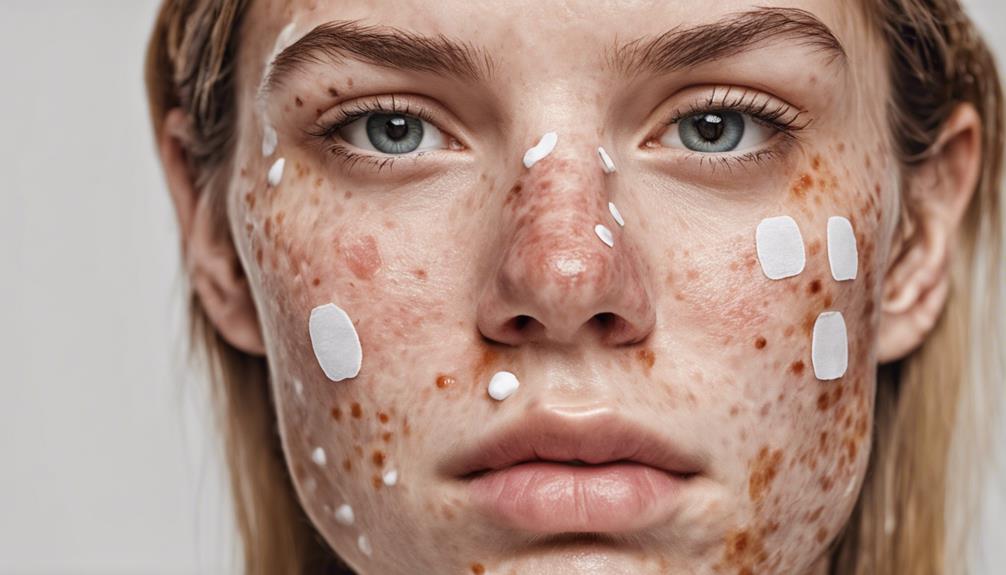
In some cases, acne patches may not exacerbate acne, but they may not offer significant improvement for most individuals. When considering whether acne patches can worsen acne, it's essential to be aware of the following facts:
- Adhesive: The adhesive used in acne patches can potentially irritate the skin around the acne lesions, especially for individuals with sensitive skin. This irritation may lead to further inflammation and discomfort.
- Salicylic Acid: Some acne patches contain ingredients like salicylic acid, which can be beneficial for treating acne. However, individuals with sensitive skin should be cautious as salicylic acid has the potential to irritate the skin, potentially worsening acne in some cases.
- Skin Type Consideration: Pimple patches are more effective for certain types of acne, such as open, draining, healing pustules, papules, and cysts. For closed or deeper lesions, acne patches may not provide significant benefits and could potentially lead to a lack of improvement or even exacerbation of the acne condition.
Using Acne Patches for Different Skin Types

Considering the varying effectiveness of acne patches based on different skin types, it's important to understand how these patches can specifically benefit individuals with certain types of acne lesions. Acne patches work best for open, draining, healing pustules, papules, and cysts. They aid in the healing process, especially for those who've a habit of picking at their skin, promoting faster recovery.
However, for individuals with sensitive skin, caution is advised as the adhesive in the patches may cause irritation. Ingredients like salicylic acid present in some patches can also potentially irritate sensitive skin types. It's vital to note that these patches aren't suitable for closed or deeper lesions, blackheads, whiteheads, or as a preventive measure.
When used correctly on the right type of acne lesions, acne patches can be a helpful tool in the healing process, but individuals with sensitive skin should be mindful of potential irritation.
Acne Patch Myths Debunked

Let's set the record straight on common misconceptions about acne patches.
- Acne Patches Do Not Work for Cystic Acne: While acne patches can be effective for open, oozing lesions, they aren't designed to treat deep cystic acne. These patches work best on surface-level pimples that have come to a head.
- They Are Not Meant for Open Wounds: Please be aware that acne patches aren't suitable for open wounds or popped pimples. They're designed to help treat already-formed lesions by providing a protective barrier and promoting faster healing.
- They Offer Relief, Not Prevention: Acne patches aren't a preventive measure for acne. Instead, they offer temporary relief and aid in the healing process of existing pimples. It's essential to incorporate other skincare practices to prevent future breakouts and maintain overall skin health.
Acne Patch Vs. Traditional Treatments
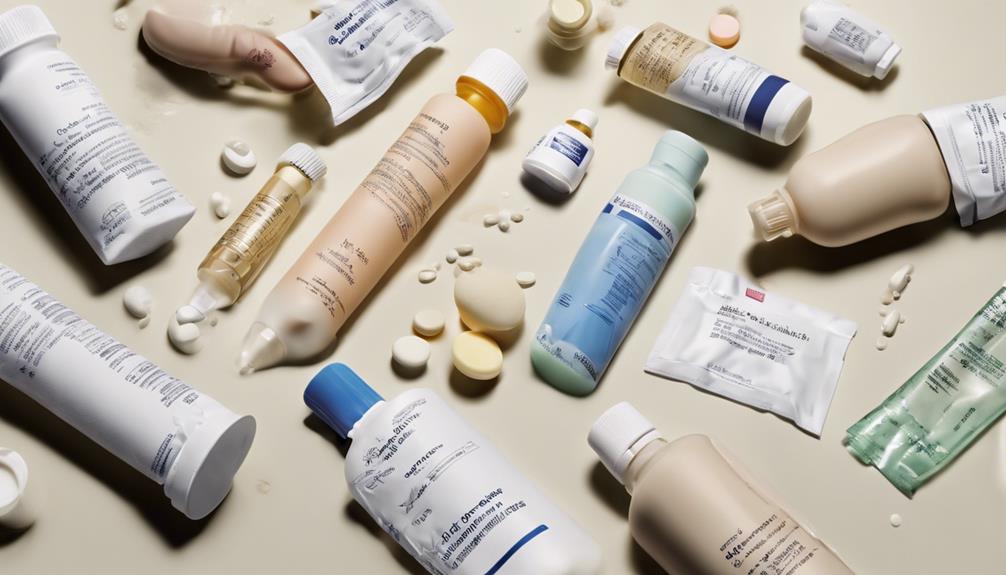
Our experience shows that acne patches provide a targeted approach for treating specific pimples, offering convenience and effectiveness compared to traditional treatments.
Acne patches work by delivering active ingredients directly to the pimple, allowing for a more focused treatment. In contrast, traditional treatments like creams or gels are applied to larger areas, possibly affecting unaffected skin and causing irritation, particularly for those with sensitive skin. The targeted approach of acne patches acts as a barrier between the active ingredients and the rest of the skin, reducing the risk of irritation.
Additionally, acne patches are convenient and discreet, making them easy to use throughout the day without drawing attention. Unlike traditional treatments that may involve multiple steps and products, acne patches streamline the process with a single application solution.
Furthermore, acne patches can be a cost-effective option for addressing individual pimples without the need to purchase larger quantities of products typically required by traditional treatments.
Potential Side Effects of Acne Patches

After applying acne patches, individuals with sensitive skin may experience skin irritation or allergic reactions as potential side effects. Here are some key points to keep in mind regarding the side effects of acne patches:
- Skin Irritation: The adhesive used in acne patches can sometimes lead to mild redness or discomfort on the skin where the patch is applied, especially for those with sensitive skin.
- Allergic Reactions: Some individuals may be allergic to the materials in acne patches, causing itching, swelling, or even a rash on the skin. It's important to stop using the patch immediately if any allergic reactions occur.
- Adhesive Sensitivity: The adhesive in acne patches can sometimes cause irritation or peeling of the skin, particularly when the patches are removed. It's crucial to be gentle when taking off the patch to minimize any potential skin damage.
Being aware of these potential side effects can help individuals make informed decisions when using acne patches to manage their acne effectively.
Tips for Maximizing Acne Patch Results

To enhance the effectiveness of acne patches, it's vital to cleanse the skin thoroughly before application. By removing any dirt, oil, or makeup residue, you create a clean surface for the patch to adhere to, allowing it to work more effectively in targeting the acne. It's important to avoid using other skincare products simultaneously with acne patches to prevent interference with their wound-healing and acne-preventing properties.
Regularly changing the patches according to the product's instructions is essential to maintain a clean and effective barrier over the acne. This helps guarantee that the hydrocolloid material in the patches can continue absorbing impurities and promoting wound healing efficiently. While results may not be immediate, being patient with the process allows the patches to work effectively over time.
For persistent or severe acne concerns that don't improve with acne patches alone, consulting a dermatologist for personalized advice and additional treatment options is recommended. Prioritizing proper patch application and following these tips can help maximize the benefits of using acne patches for clearer, healthier skin.
Frequently Asked Questions
Do Acne Patches Actually Help?
Acne patches can be helpful for certain types of pimples, like pustules and papules, by absorbing drainage and aiding in healing.
While they may not worsen acne, they aren't a cure-all and may not improve it either.
It's essential to understand that acne patches aren't preventative and only treat active bumps.
For some individuals, they may speed up the healing process, but they aren't a solution for all acne concerns.
Do Dermatologists Recommend Pimple Patches?
Yes, dermatologists often recommend pimple patches as a targeted treatment for specific types of acne lesions. These patches can aid in preventing further skin trauma and reducing inflammation in open, draining pimples.
Hydrocolloid patches are commonly used by dermatologists to absorb excess oil and promote healing in select acne lesions. When used correctly under dermatological guidance, pimple patches can be a beneficial addition to a skincare regimen.
How Long Does It Take for Pimple Patches to Work?
When using pimple patches, visible improvement in pimple size and inflammation can occur overnight. Results, like reduced redness and swelling, may show in as little as 6-8 hours.
These patches work best on open pimples by absorbing excess fluid and promoting healing. Consistent use can lead to faster recovery and reduced scarring.
It's important to follow the instructions and be patient for best results.
Do Pimple Patches Work on Unpopped Pimples?
Pimple patches are most effective on open, draining, and healing pimples. They work by absorbing drainage and aiding healing.
However, they aren't designed for unpopped pimples. Patches help prevent skin trauma, reduce inflammation, but aren't suitable for closed or deep-seated pimples like blackheads or cystic acne.
For best results, apply over an open wound and follow recommended usage time for best healing outcomes.
Are Hello Kitty Acne Patches as Effective as Regular ones?
Yes, cute hello kitty acne patches are just as effective as regular ones. These adorable patches not only help to clear up acne but also make the treatment process a bit more fun. The key ingredients in these patches work just as effectively as any other acne treatment.
Conclusion
To sum up, acne patches have been demonstrated to effectively target and treat acne, offering a convenient and non-invasive solution for many individuals.
While results may vary, integrating acne patches into your skincare routine can help reduce inflammation and promote healing.
By understanding how acne patches work and selecting the right one for your skin type, you may potentially notice improvement in your acne condition.
Give acne patches a try and see if they work for you!
Claire has a knack for turning complex dermatological concepts into engaging, easy-to-understand articles. Her work primarily focuses on creating detailed reviews and thought-provoking articles in the “Vetted” category. Claire’s writing not only informs but also inspires our community to try new skincare solutions.
